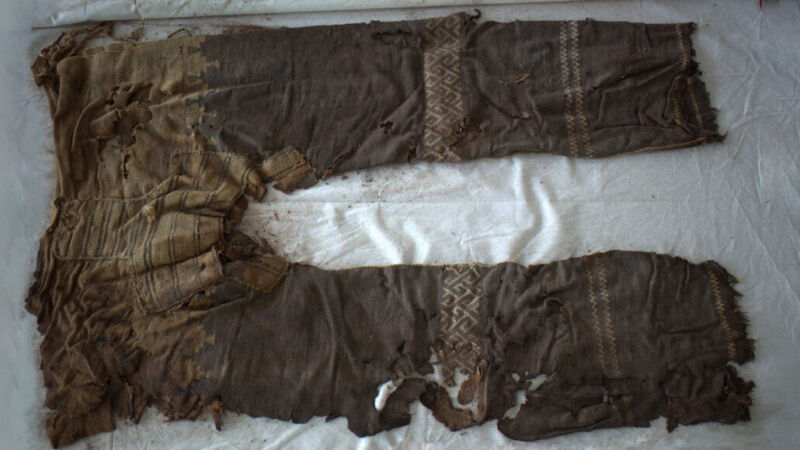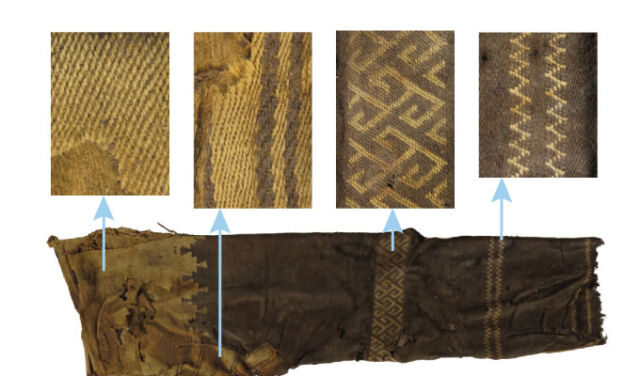The world’s oldest pants are a 3,000-year-old engineering marvel
The world’s oldest pants are a 3,000-year-old engineering marvel
Strong in some places and flexible in others, the pants were designed for horseback riding.

Wagner et al. 2022
With the help of an expert weaver, archaeologists have unraveled the design secrets behind the world’s oldest pants. The 3,000-year-old wool trousers belonged to a man buried between 1000 and 1200 BCE in Western China. To make them, ancient weavers combined four different techniques to create a garment specially engineered for fighting on horseback, with flexibility in some places and sturdiness in others.
The softer side of materials science
Most of us don’t think much about pants these days, except to lament having to put them on in the morning. But trousers were actually a technological breakthrough. Mounted herders and warriors needed their leg coverings to be flexible enough to let the wearer swing a leg across a horse without ripping the fabric or feeling constricted. At the same time, they needed some added reinforcement at crucial areas like the knees. It became, to some extent, a materials-science problem. Where do you want something elastic, and where do you want something strong? And how do you make fabric that will accomplish both?
For the makers of the world’s oldest pants, produced in China around 3,000 years ago, the answer was apparently to use different weaving techniques to produce fabric with specific properties in certain areas, despite weaving the whole garment out of the same spun wool fiber.
The world’s oldest-known pants were part of the burial outfit of a warrior now called Turfan Man. He wore the woven wool pants with a poncho that belted around the waist, ankle-high boots, and a wool headband adorned with seashells and bronze discs. The pants' basic design is strikingly similar to the pants most of us wear today, but closer inspection reveals the level of engineering that went into designing them.
Along with her colleagues, archaeologist Mayke Wagner of the German Archaeological Institute recently examined the 3,000-year-old trousers in detail. A modern weaver created a replica of the pants to better understand the techniques that produced this piece of fashion history.
Roomy where it counts
Most of the pants are woven in what’s called twill, which you might recognize if you’ve ever put on a pair of jeans. The oldest known twill fabric in the world comes from the Hallstatt salt mine in Austria, and it has been radiocarbon dated to a bit earlier than the pants, between 3,500 and 3,200 years ago. Twill makes a diagonally ribbed, heavy fabric that’s also stretchier than the original wool thread.
Based on the other objects in his grave, which included a battle ax, a bridle, and a horse bit, Turfan Man probably spent a significant part of his time fighting on horseback, so that stretchy twill fabric would have saved him the embarrassment of ripping his pants every time he swung into the saddle. For added roominess, the ancient weaver made the crotch piece of the pants wider at the center than the ends, so the piece of fabric could bunch up or stretch in the middle to give the wearer more flexibility where it really counted.

Wagner et al. 2022
Flexibility isn’t everything, though, especially for the rough use a mounted warrior’s clothing probably got. At the knees, the ancient weaver switched to a different weaving method, called tapestry weaving, which produces a less flexible but thicker, sturdier fabric. At the waist, a third weaving method provided a thick waistband to help hold the pants in place, no doubt preventing extremely embarrassing battlefield incidents.
And all of those components were woven as a single piece; there's no evidence of any of the fabric having been cut.
The traveling pants (sort of)
The Turfan trousers are an extremely functional design, but they’re also pretty damn fancy. As the weaver was working on that stretchy, roomy crotch piece, they alternated different colors of weft threads to create pairs of brown stripes on an off-white background. Zigzag stripes adorn the ankles and calves of the pants, along with a design similar to a step pyramid. That pattern led Wagner and her colleagues to speculate that Turfan Man’s culture might have had some contact with people in Mesopotamia, leading them to include ziggurats in a woven motif.
Other aspects of the pants reveal interactions between far-flung groups of people ranging from modern Kazakhstan to Eastern Asia. Across the knees, a pattern of tilted, interlocking T-shapes looks remarkably like a pattern that turned up on bronze containers from a 3,300-year-old site in China and on pottery at 3,800- to 3,000-year-old sites in Western Siberia—about the same age as the trousers but roughly 3,000 kilometers apart.
The tapestry weaving that gives strength to the trousers’ knees was first developed by weavers in Southwestern Asia. Twill, which makes the rest of the pants so flexible, probably originated in Northwestern Asia (people as far west as Austria were also using the technique by 3,200 years ago, although it’s possible that people in both places developed twill independently).
In other words, inventing pants was a matter of combining different weaving techniques from cultures thousands of kilometers apart. Weavers at Yanghai, the Tarim Basin oasis where Turfan Man is buried, had the opportunity to make that connection thanks to geography and nomadism. In general, Turfan Man’s people made their living by driving herds of livestock across the steppes. Their annual routes covered great distances, and Yanghai happened to be a central point in a huge network of herding routes that linked far-flung corners of Eurasia—and which eventually evolved into the trade routes known as the Silk Road.
MMW


Comments
Post a Comment